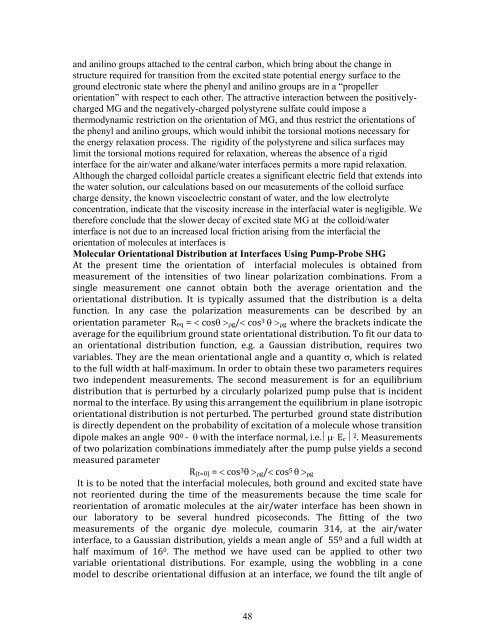Eighth Condensed Phase and Interfacial Molecular Science (CPIMS)
Eighth Condensed Phase and Interfacial Molecular Science (CPIMS)
Eighth Condensed Phase and Interfacial Molecular Science (CPIMS)
Create successful ePaper yourself
Turn your PDF publications into a flip-book with our unique Google optimized e-Paper software.
<strong>and</strong> anilino groups attached to the central carbon, which bring about the change in<br />
structure required for transition from the excited state potential energy surface to the<br />
ground electronic state where the phenyl <strong>and</strong> anilino groups are in a “propeller<br />
orientation” with respect to each other. The attractive interaction between the positivelycharged<br />
MG <strong>and</strong> the negatively-charged polystyrene sulfate could impose a<br />
thermodynamic restriction on the orientation of MG, <strong>and</strong> thus restrict the orientations of<br />
the phenyl <strong>and</strong> anilino groups, which would inhibit the torsional motions necessary for<br />
the energy relaxation process. The rigidity of the polystyrene <strong>and</strong> silica surfaces may<br />
limit the torsional motions required for relaxation, whereas the absence of a rigid<br />
interface for the air/water <strong>and</strong> alkane/water interfaces permits a more rapid relaxation.<br />
Although the charged colloidal particle creates a significant electric field that extends into<br />
the water solution, our calculations based on our measurements of the colloid surface<br />
charge density, the known viscoelectric constant of water, <strong>and</strong> the low electrolyte<br />
concentration, indicate that the viscosity increase in the interfacial water is negligible. We<br />
therefore conclude that the slower decay of excited state MG at the colloid/water<br />
interface is not due to an increased local friction arising from the interfacial the<br />
orientation of molecules at interfaces is<br />
<strong>Molecular</strong> Orientational Distribution at Interfaces Using Pump-Probe SHG<br />
At the present time the orientation of interfacial molecules is obtained from<br />
measurement of the intensities of two linear polarization combinations. From a<br />
single measurement one cannot obtain both the average orientation <strong>and</strong> the<br />
orientational distribution. It is typically assumed that the distribution is a delta<br />
function. In any case the polarization measurements can be described by an<br />
orientation parameter Req = � cos� ��g/� cos3 � ��g where the brackets indicate the<br />
average for the equilibrium ground state orientational distribution. To fit our data to<br />
an orientational distribution function, e.g. a Gaussian distribution, requires two<br />
variables. They are the mean orientational angle <strong>and</strong> a quantity �, which is related<br />
to the full width at half‐maximum. In order to obtain these two parameters requires<br />
two independent measurements. The second measurement is for an equilibrium<br />
distribution that is perturbed by a circularly polarized pump pulse that is incident<br />
normal to the interface. By using this arrangement the equilibrium in plane isotropic<br />
orientational distribution is not perturbed. The perturbed ground state distribution<br />
is directly dependent on the probability of excitation of a molecule whose transition<br />
dipole makes an angle 900 ‐ � with the interface normal, i.e. �� . Ec �2 . Measurements<br />
of two polarization combinations immediately after the pump pulse yields a second<br />
measured parameter<br />
R(t=0) = � cos3� ��g/� cos5 � ��g<br />
It is to be noted that the interfacial molecules, both ground <strong>and</strong> excited state have<br />
not reoriented during the time of the measurements because the time scale for<br />
reorientation of aromatic molecules at the air/water interface has been shown in<br />
our laboratory to be several hundred picoseconds. The fitting of the two<br />
measurements of the organic dye molecule, coumarin 314, at the air/water<br />
interface, to a Gaussian distribution, yields a mean angle of 550 <strong>and</strong> a full width at<br />
half maximum of 160 . The method we have used can be applied to other two<br />
variable orientational distributions. For example, using the wobbling in a cone<br />
model to describe orientational diffusion at an interface, we found the tilt angle of<br />
48
















